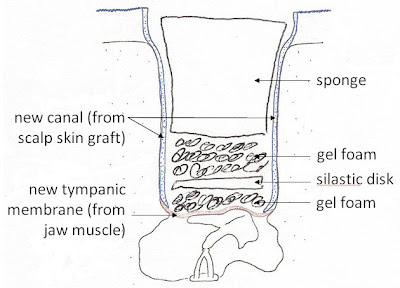Here's the procedure that Dr Joseph Roberson performed today for Kai (provided on a checklist they gave us):
Right Reconstruction of External Auditory Canal for Congenital Atresia, Tympanoplasty, Split-thickness Skin Graft, Ossicular Reconstruction for Congenital Anomaly, Continuous Intraoperative 7th Nerve Monitoring, Baseline Electrophysiologic Study, Microdissection
My understanding of the above: Dr Roberson created the ear canal with skin from the split-thickness skin graft, which they took from Kai's scalp on the right side of his head. For the tympanoplasty (creating the eardrum), Dr Roberson took a graft from a muscle in the jaw. As far as "ossicular reconstruction" (rebuilding the
middle ear bones), it sounded like Dr Roberson didn't feel it was necessary. He said the stapes wasn't as flexible as he'd like but it was good enough. Apparently, the "7th nerve" is the facial nerve. They monitored proximity to it to ensure they didn't get too close and accidentally cause damage. I'm assuming "baseline electrophysiologic study" just means they tracked his vital signs and, frankly, I have no idea what they mean by "microdissection". I'll have to ask tomorrow.
Most importantly, the surgery went well and the prognosis is excellent. The only bit of trouble occurred when they removed the breathing tube--apparently, he woke up flailing and managed to remove the bandage around his head. To quiet him, the anesthesiologist gave him a healthy dose of Fentanyl, which Keddrick says is similar to morphine but has a shorter half-life. (Keddrick, the experienced surgical patient, says he personally prefers Demerol above all others.)

Here's Kai in the recovery room sleeping peacefully with his new purple turban:
He woke up gradually and was able to go home about two hours later.
Altogether, we were there for 6 hours. Seemed short to me but I'm still amazed that it's an outpatient procedure.
Here Kai is again sleeping with his favorite blanket ("flower") on the way back to the hotel:












